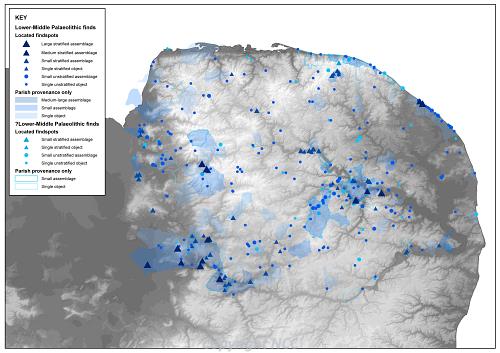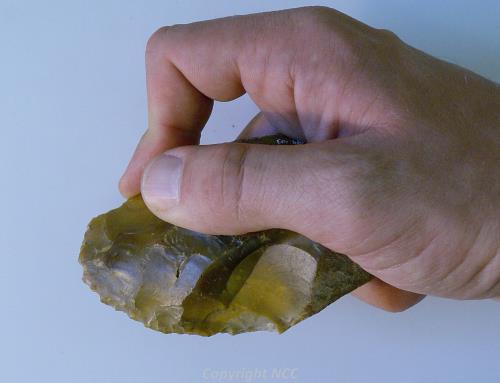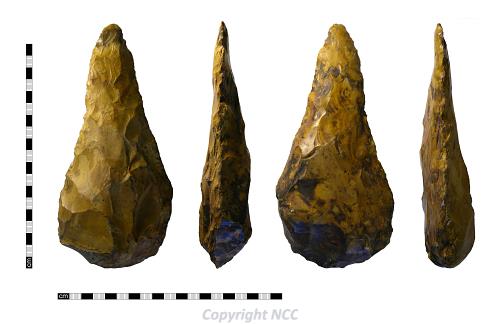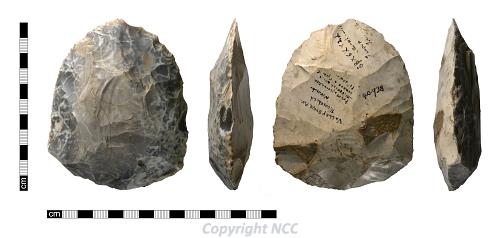As across much of the country, the archaeological evidence for Lower and Middle Palaeolithic activity in Norfolk is almost entirely restricted to flint tools and the waste from their manufacture. The first recognised Palaeolithic objects were recovered during the 1860s, soon after discoveries in France had been accepted as conclusive proof of human antiquity. Numerous Palaeolithic finds were recovered in Norfolk over the following decades and there are now over 280 individual sites where such material is known to have been found.

Figure 1. Lower-Middle Palaeolithic finds.
As elsewhere, the most common finds are the bifacial cutting and chopping implements known as handaxes. A range of simple flakes tools, cores and unmodified flakes of probable Lower–Middle Palaeolithic date have also been recovered. Although a proportion of the objects found to date have been stray surface finds, the majority have been recovered as a result of aggregate extraction and other activities that have disturbed sub-surface deposits. Only a small number of sites have produced material that was in relatively undisturbed primary contexts. The majority of the assemblages recovered represent material that had accumulated as a result of natural glacial and fluvial processes.

Figure 2. Lower Palaeolithic flint scraper from Postwick (NHER 31087).
Until relatively recently it had been thought unlikely that Britain (or indeed any part of northern Europe) had been occupied much before around 500,000 BP. Important discoveries made on the East Anglian coast have however now demonstrated that the first hominins had almost certainly reached Britain several hundred thousand years earlier. At this time the region was crossed by two major rivers that flowed out into the North Sea basin via what is now the East Anglian coast; an ancestral Thames running far to the north of its present course and the River Bytham, which flowed south-east from the midlands. Sediments that formed on the margins of these ancient rivers are now exposed intermittently along a long stretch of the Norfolk and Suffolk coast. Known as the Cromer Forest-Bed formation, these deposits are rich in both plant remains and the fossils of extinct mammal species. As these deposits lie beneath later glacial tills their chronological significance has long been recognised, although many decades of investigation had until recently failed to recover any convincing evidence for hominin activity. This situation changed in 2000 when a handaxe in remarkably fresh condition was found within Forest-Bed deposits exposed on the foreshore at Happisburgh (NHER 35385). This discovery generated considerable interest and a programme of excavation was subsequently undertaken at the site (designated Happisburgh 1) by the Ancient Human Occupation of Britain (AHOB) Project. This work did however conclude that these finds, whilst amongst the earliest known in Norfolk at the time, were not as old as initially thought. Excavation at another nearby site (Happisburgh 3; NHER 54222) did however produce material that appeared to be considerably earlier in date. Here a small assemblage of struck flints was recovered from river channel deposits thought to date to between approximately 900,000 and 800,000 BP, making these finds by far the earliest evidence for a hominin presence in Britain. Around the same time a similar but apparently slightly younger assemblage of worked flints was recovered on the Suffolk coast at Pakefield. At present the only hominin species known to have been in Europe this early is Homo antecessor, which was present in the Atapuerca region of Spain around 1 million years ago. It is therefore likely that flints found at Happisburgh 3 were made by either Homo antecessor or an as yet unidentified descendent of this species. Although the exact nature of the hominins present at Happisburgh remains uncertain, a recent discovery provided quite remarkable evidence for their presence in this Early Pleistocene landscape. In 2013 coastal erosion exposed an area of laminated silts on the Happisburgh foreshore that appear to be of a similar age to those from which the worked flints had been recovered. On the surface of these silts was a series of clearly-defined footprints that had been left by a group of at least five individuals as they walked across the mudflats of the estuary (NHER 60000).
Although these recent discoveries are of considerable significance it is entirely possible that these initial phases of activity were associated with only intermittent occupation by quite small hominin populations. It remains the case that we do not have evidence for sustained occupation in the country until around 500,000 years ago, when it appears that there was a period of relatively intensive activity during the warm period that preceded the Anglian glaciation. This glaciation, which peaked around 450,000 BP, was particularly severe and saw much of the country buried beneath ice, including (apparently for the first time) the whole of Norfolk. The advance and subsequent retreat of the Anglian ice sheets created much of Norfolk’s present topography, eradicating the earlier river systems, excavating the Fenland basin and depositing extensive clayey till across large parts of the county. Most of the surviving archaeological evidence for earlier activity will have been destroyed or at least significantly disturbed. A number of sites do however appear to have produced material that relates to this pre-Anglian phase of activity, the most securely dated being that recovered during the recent excavations at Happisburgh 1 (NHER 35385). Also likely to be of a similar age are a cluster of sites that straddles the county boundary to the west of Thetford, which are associated with the surviving Bytham River sands and gravels. Several of these sites produced particularly large handaxe assemblages, with the most productive Norfolk site being a series of quarry pits at Shrub Hill, Feltwell (NHER 5292). It is likely that at least some of the smaller assemblages found elsewhere in the county represent disturbed pre-Anglian finds, particular the small number of handaxes that have been recovered from within Anglian tills and outwash sands and gravels. It appears that this pre-Anglian phase of activity marks the first appearance of handaxe-dominated ‘Acheulian’ assemblages. It is likely that these early handaxe assemblages were associated with a hominin species known as Homo heidelbergensis, which first appeared in Europe around 600,000 years ago and was probably the ancestor of both the Neanderthals and modern humans.
Britain was again occupied as conditions ameliorated at the end of the Anglian glaciation and it is likely that many of the Palaeolithic finds from Norfolk were associated with activity during this and subsequent warmer periods. These include the many finds that have been recovered from terrace gravels and related deposits along the counties major river valleys. The Little Ouse river in south-west Norfolk has proven to be a particularly productive area, with several sites along its valley having produced large Palaeolithic assemblages. Of these the most notable is a site to the north-west of Thetford known as Red Hill, where it is recorded that as many as 6,000 implements were recovered during the late 19th century (NHER 5795). A number of other quarry pits in the Thetford area and in the neighbouring parish of Weeting with Broomhill have produced smaller handaxe assemblages. In west Norfolk a notable number of sites along the Nar Valley have produced Palaeolithic material, with the most productive sites being a series of quarry pits in the vicinity of South Acre (NHER 4097; NHER 4099). In central Norfolk many objects have been recovered from the terrace gravels in the valleys of the Rivers Wensum and Yare and their tributaries. Keswick Mill Pit (NHER 9560) and Whitlingham Sewage Farm (NHER 9663), both near Norwich, were the most productive sites, both producing well over 100 handaxes when they were being worked during the early 20th century. Unfortunately few of these post-Anglian, Late Lower Palaeolithic sites can be assigned a precise date. This reflects not only the relatively uncontrolled conditions under which most of these assemblages were recovered but also difficulties in establishing the exact date of the various geological deposits from which they were derived. In most cases all we can say is that these sites represent activity between the end of the Anglian glaciation around 425,000 BP and 250,000 BP, after which it appears that handaxes were, at least for a time, no longer produced. It is therefore difficult to characterise the nature and intensity of activity during this long period, which saw several climatic cycles.

Figure 3. Lower Palaeolithic flint handaxe from Keswick (NHER 9560).
The transition from the Lower Palaeolithic to the Middle Palaeolithic is marked by the emergence of new core preparation techniques around 300,000 years ago. Generally referred to as Levallois, these techniques allowed flakes of predetermined form and with long cutting edges to be struck from carefully prepared cores. The development of this new technology and the subsequent decline of handaxe-dominated assemblages appear to have coincided with the arrival of the first Neanderthal populations (Homo Neanderthalensis). The exact nature and extent of activity in Norfolk during the early part of the Middle Palaeolithic is far from clear. Levallois flakes, cores and implements are fairly scarce, with the majority having been recovered in small quantities from sites along the county’s principal river valleys. This is typical of the distribution seen across much of the country, where only the river Thames is associated with a notable concentration of more productive sites.

Figure 4. Middle Palaeolithic flint Levallois flake from Gresham (NHER 6563).
Britain was almost certainly abandoned during a glacial period that reached its climax around 150,000 BP and it is now thought that hominids were also absent during the subsequent Ipswichian interglacial, probably as Britain had been cut off from the continent by rising sea levels. It appears that Neanderthal groups did not return until around 60,000 BP, during a warmer episode in the initial stages of the final Pleistocene glacial period. Exactly when and how they disappeared from Britain remains somewhat unclear, although there is no convincing evidence for their presence after 35,000 BP, around the time that we see the first definitive evidence for the presence of full modern Homo sapien populations in Britain. This Late Middle Palaeolithic phase of activity saw a return to the production of bifacial handaxes, many of which have a distinctive flat-butted cordate form (often described as bout coupé type). The presence of handaxes means that assemblages of this date have often been described as ‘Mousterian of Acheulian Tradition’.

Figure 5. Late Middle Palaeolithic flint handaxe from Mousehold Heath, Norwich (NHER 468).
It appears that Levallois implements were now rare. Finds of Late Middle Palaeolithic date, mostly handaxes, have been recovered from no more than 25 sites in Norfolk. These objects have a fairly dispersed distribution, although there is a slightly concentration along the River Wissey and its tributaries. It was within this latter area that a Late Middle Palaeolithic site of national significance was discovered in 2002, within a activity pit at Lynford Quarry (NHER 37095). A watching brief identified a palaeochannel, the dark organic fill of which was found to contain flint implements in close association with fossil faunal remains. A subsequent excavation of the surviving portion of this deposit recovered over 2,500 lithic objects (including at least 40 bifacial implements) and a large faunal assemblage that included the bones of at least 11 individual mammoths. This site provided not only clear evidence for some form of interaction between a Late Middle Palaeolithic Neanderthal population and mammoths but also a wealth of palaeoenvironmental information. Another significant assemblage of Late Middle Palaeolithic artefacts was recovered as a result of off-shore dredging near Great Yarmouth (NHER 51516). A total of 88 worked flints were recovered, including 33 handaxes, all of which were found in stockpiles and reject heaps at a wharf in the Netherlands. These finds were reported as part of the Marine Aggregate Industry Protocol for the Reporting of Finds of Archaeological Interest and traced back to relatively discrete area off the Norfolk coast. This importance of this relatively fresh material is that it suggests relatively undisturbed Middle-Late Pleistocene deposits survive on what is now the sea bed.